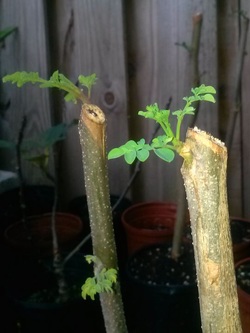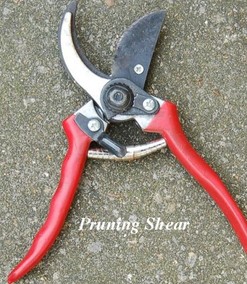How to prune moringa trees

When you prune a moringa tree, be certain to take your time and observe exactly where you are going to make the cut. In the photo you will notice a 45 degree cut just slightly above a leaf node. When the tree is cut too far up the remaining wood rots quickly and can lead to disease and death of your branch or possibly the entire tree.
Most moringa trees will exude a clear gum like substance at the point of pruning.
Proper pruning will encourage rapid healing of wounds. Use a pruning tool appropriate to the size of the branch. Using the right tool will make all cuts clean and smooth. All pruning equipment must be sharp and disinfected prior to use. Avoid tearing the bark when removing large branches.
Pruning shears come in three basic types. The scissor type, The anvil and the lopping type. A top quality lopping shear (scissor action) can cut a branch up two 2 inches in diameter. Hand pruners generally will give a good cut on stems no larger than 1/2 inch diameter.
Tip: By cutting to an outside bud, the new shoots will be less likely to grow through the interior of the plants or crisscross. This will give you plenty of air circulation between the branches and help keep your moringa tree looking good and in greater heath.
Most moringa trees will exude a clear gum like substance at the point of pruning.
Proper pruning will encourage rapid healing of wounds. Use a pruning tool appropriate to the size of the branch. Using the right tool will make all cuts clean and smooth. All pruning equipment must be sharp and disinfected prior to use. Avoid tearing the bark when removing large branches.
Pruning shears come in three basic types. The scissor type, The anvil and the lopping type. A top quality lopping shear (scissor action) can cut a branch up two 2 inches in diameter. Hand pruners generally will give a good cut on stems no larger than 1/2 inch diameter.
Tip: By cutting to an outside bud, the new shoots will be less likely to grow through the interior of the plants or crisscross. This will give you plenty of air circulation between the branches and help keep your moringa tree looking good and in greater heath.
Disinfecting Pruning Tools
Disinfecting pruning tools, is it really necessary? Well the answer is maybe. Now let me tell you what I really think. I think yes you should.
Okay that is obviously confusing. First realize that your plant is more likely to be infected by disease if pruned with a tool that had been used on a diseased plant. Certainly it is smart to take no chances and disinfect your tools. If you never pruned a diseased plant, then maybe you could get away with no disinfection. Plants can be infected more often by your own hands, while touching them than by pruning tools. Be especially careful when plants are wet and you handle them. Also don't prune when the plants are wet.
Before you use any disinfecting solution read the label and make sure it is safe for you and the plant.
Here are some typical solutions used in horticulture.
Household bleach: 25% solution (1 part bleach + 3 parts water) Can be very corrosive to your tool!
Rubbing alcohol (70% isopropyl): 50% solution (1 part alcohol + 1 part water)
Here are some you might not have considered and they are very effective!
Household cleaners (Listerine, Lysol, Pine-Sol)*
1) Brush away all debris from your tools prior to soaking them in a solution.
2) Pruning tools should be soaked for at least 5 minutes and rinsed with clean water or allowed to air dry before use. A longer soaking period may be needed for pruning tool surfaces that are not smooth. Sterilizing your tools is no guarantee against plant disease, but it can significantly reduce disease incidence and severity.
Okay that is obviously confusing. First realize that your plant is more likely to be infected by disease if pruned with a tool that had been used on a diseased plant. Certainly it is smart to take no chances and disinfect your tools. If you never pruned a diseased plant, then maybe you could get away with no disinfection. Plants can be infected more often by your own hands, while touching them than by pruning tools. Be especially careful when plants are wet and you handle them. Also don't prune when the plants are wet.
Before you use any disinfecting solution read the label and make sure it is safe for you and the plant.
Here are some typical solutions used in horticulture.
Household bleach: 25% solution (1 part bleach + 3 parts water) Can be very corrosive to your tool!
Rubbing alcohol (70% isopropyl): 50% solution (1 part alcohol + 1 part water)
Here are some you might not have considered and they are very effective!
Household cleaners (Listerine, Lysol, Pine-Sol)*
1) Brush away all debris from your tools prior to soaking them in a solution.
2) Pruning tools should be soaked for at least 5 minutes and rinsed with clean water or allowed to air dry before use. A longer soaking period may be needed for pruning tool surfaces that are not smooth. Sterilizing your tools is no guarantee against plant disease, but it can significantly reduce disease incidence and severity.
*Naming of companies or products is neither meant to imply endorsement by the author nor criticism of similar companies or products not mentioned. Most of the information on this page is based on my personal experience. Also we credit research from of the University of Florida
and Dr. Linda Chalker-Scott: Sterilized Pruning Tools: Nuisance or Necessity?
and Dr. Linda Chalker-Scott: Sterilized Pruning Tools: Nuisance or Necessity?

